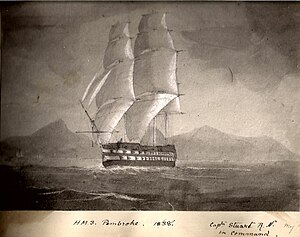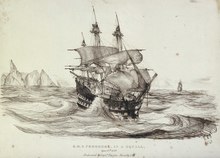HMS Pembroke (1812)

| |
| History | |
|---|---|
| Name | HMS Pembroke |
| Ordered | 17 May 1808 |
| Builder | Wigram, Wells & Green, Blackwall Yard |
| Laid down | March 1809 |
| Launched | 27 June 1812 |
| Fate | Sold, 1905 |
| General characteristics [1] | |
| Class and type | Template:Sclass- |
| Tons burthen | 1758 bm |
| Length | 176 ft (54 m) (gundeck) |
| Beam | 47 ft 6 in (14.48 m) |
| Depth of hold | 21 ft (6.4 m) |
| Propulsion | Sails |
| Sail plan | Full rigged ship |
| Armament |
|
HMS Pembroke was a 74-gun third rate ship of the line of the Royal Navy, launched on 27 June 1812 at Blackwall Yard.[1]
As a part of a squadron under the command of Sir James Brisbane the Pembroke in company with Alcmene and Aigle on 11 April 1814 captured Fortune, Notre Dame de Leusainte, and a settee [1] of unknown name, at Fort Maurigio, in the Gulf of Genoa, near Monaco. The squadron silenced the fort's guns, and attacked 20 vessels; 4 were captured, and the cargoes of another 15 taken off ships whose crews scuttled them.[2][3][4][Note 1]
In 1836 she formed part of an experimental squadron, which were groups of ships sent out in the 1830s and 1840s to test new techniques of ship design, armament, building and propulsion. She was fitted with screw propulsion in 1855, transferred to the Coastguard in 1858, and used as a base ship from 1887.

She was renamed HMS Forte as a receiving hulk in 1890, and was eventually sold out of the Navy in 1905.[1]

Notes
Citations
- ^ a b c Lavery, Ships of the Line vol.1, p189.
- ^ "The squadron under the command of Sir J. Brisbane attacking Fort Maurigio. From a sketch by Sir J. Brisbane". grosvenorprints.com. Retrieved 30 June 2018.
- ^ "The Squadron under the command of Sir J Brisbane attacking Fort Maurigio. From a sketch by Sir J Brisbane". collections.rmg.co.uk. Retrieved 30 June 2018.
- ^ "No. 16943". The London Gazette. 8 October 1814. p. 2009.
Publications
- Colledge, J. J.; Warlow, Ben (2006) [1969]. Ships of the Royal Navy: The Complete Record of all Fighting Ships of the Royal Navy (Rev. ed.). London: Chatham Publishing. ISBN 978-1-86176-281-8.
- Lavery, Brian (2003) The Ship of the Line - Volume 1: The development of the battlefleet 1650-1850. Conway Maritime Press. ISBN 0-85177-252-8.
